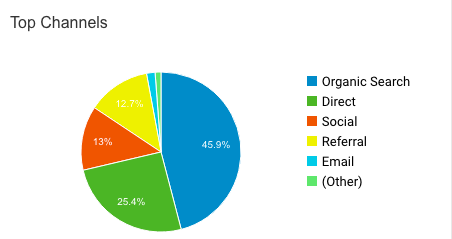How to do a content audit of your website


Are you one of those companies that produce and publish lots of content but is not sure what the results of it are?
Then it's time for a good content audit.
As HubSpot points out, while the goal of content marketing is clear, many companies forget to track what type of content is actually working.
Even Microsoft made the same mistake. At one point the Microsoft.com website had 10 million pages of content but 3 million of them had never been visited. By removing unnecessary and irrelevant content, Microsoft made its customers much happier and learned what type of content works in attracting consumers. And all of that happened by conducting a content audit.
In this article I will focus specifically on how to find out what content is the most effective in attracting visitors, converting leads and gaining you new customers. If you follow everything step by step you will be able to get a good understanding of what works and what doesn't on your website and create a new, more effective content plan going forward.
FREE EBOOK: Want to learn more about creating an effective inbound content strategy? Download now the free ebook on everything you need to know about inbound marketing
First things first: do a content inventory
Before analysing the content, you first need to understand what content you have.
- Use a crawl tool like Screaming Frog to gather all the available URLs on your website and put them in one column on an excel spreadsheet.
- Understand what you want to measure for each piece of content, such as type of content, word count, calls to action (number and clicks), author, publication date, number of visitors, number of times the form has been filled (if there is one), major sources of traffic, keywords used, average time on the page, bounce rate, etc. Put all of these inside your spreadsheet.
![]()
Content that attracts visitors
Where is most of your traffic coming from? What are the most effective sources of traffic you should focus your efforts on and what channels are not doing much for you? Here are a couple of tools you can use to help you in this search.
- Use the acquisition section inside Google Analytics to find out what the most popular sources of traffic are for your content. Get an overall view of it and then go more granular on a page by page basis, so you start seeing patterns of what source is strongest for each type of content.

- Use tools like BuzzSumo to understand the social media engagements with your pages, and understand what content resonates the most with your social audience. However, bear in mind that
Content that converts leads
Having content for content's sake won't do anything to your bottom line. What you need for people to do once they have read a social media post or blog article is to click onto a call to action that will take them to a landing page specifically designed to capture their details and convert them into a lead.
- Indentify any page that you have that contains a form and analyse it based on two metrics: number of visits and number of conversions. A good benchmark to aim for would be that 20% of the visitors convert into leads on these pages.
- Identify where the majority of your leads come from, may they be from particular blog posts, calls-to-action on your website, third-party websites, etc.
Content that closes customers
Ultimately, you want to make sure you close your leads into customers, and content can help you doing just that. But exactly which content?
- If the content has been included inside workflows or emails to leads, analyse how these have been performing in terms of clicks and purchases/consultations.
- Analyse what content has been used in sales conversations and interrogate your salespeople on which articles have been most helpful in closing customers.
- Start tracing back the path of your customers, and link them to how they first came onto the website and where exactly their converted into a lead and then a customer. For this, you will need a good marketing automation software, like HubSpot, that is able to track all actions of a contact from the first time they visit your content to the moment they make a purchase.
Draw your conclusions
It’s not enough to produce a giant spreadsheet, but now your goal should be to analyse it and define the gaps and issues, as well as identify strengths, and develop specific recommendations for improvement. These are some things you can do once you have analysed everything
- Create an editorial calendar similar to the blog posts that have been the strongest in terms of visits and conversions.
- Optimise the blog posts that have been performing well in terms of visits but not in terms of clicks on calls to actions.
- Optimise the landing pages that have been underperforming to increase visits or conversions, depending on your findings.
- Individuate stumbling blocks that prevent users from becoming leads and customers and remove them.
More from Inbound Marketing

5 Content Formats Your Audience Wants More Of
According to the State of Inbound 2016 report, above all else, marketers' priorities today are to convert more of their...
7 Great Content Offer Examples
Get your creative juices flowing with these inspiring examples of absolutely fantastic content offers but first of all, what...







